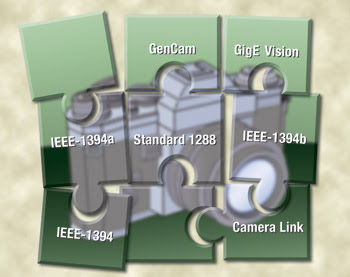Toshi Hori, JAI Pulnix Inc.
One of the greatest challenges to automated imaging manufacturers is to build equipment to widely accepted standards, thereby assuring compatibility, reduced costs and increased market acceptance. Several standards are in place, some developed by groups of companies and others by industry groups such as the Automated Imaging Association (AIA).

The AIA’s standards committees are instrumental in developing new and emerging standards for the industry, and they often endorse those developed by company consortiums. The advantage of working with the AIA is that the committees are formed of many experienced engineers, offering far more talent than any single company could on its own.
The automated imaging industry has been guided by several standards in the past, and a variety are under development. Several take the common standards many steps further:
GigE Vision. A new digital interface and communications standard designed for the machine vision industry, called GigE Vision, is under development by the AIA GigE Vision Standard Committee. This standard is a high-speed (1 Gb/s) version of Ethernet, the dominant connection protocol. More than 40 companies have joined the committee, even before the standard has been fixed formally. This indicates a very strong interest in standardization among industrial companies.
Camera Link. A common standard today is Camera Link, which allows machine vision cameras to interface digitally with frame grabbers. It is being improved continuously, and a number of Japanese companies recently expressed interest in making changes to allow for a miniature connector with power input.
IEEE-1394. The IEEE-1394 standardization effort for machine vision applications is progressing. Also called FireWire, it is a common standard, and it supports data transfer speeds of 400 Mb/s (1394a) and 800 Mb/s (1394b).
GenCam. GenCam, a new standard in the process of being established, aims to incorporate GigE, Camera Link and IEEE-1394. It is a broad camera-configuration control standard that allows all cameras to be identified and configured from common software. One piece of application programming interface software will be able to communicate with a variety of cameras made by different manufacturers.
Standard 1288. The European Machine Vision Association has another guideline in development. “The Standard for Measurement and Presentation of Specifications for Machine Vision Sensors and Cameras,” or Standard 1288, is not a connectivity standard, but one that defines how data sheets are to be written. Today, many camera or sensor specifications are written in extremely vague terms, without detailed descriptions. As a result, it can be difficult to tell from product data sheets whether camera and sensor products accurately reflect the specifications they are designed to meet. The AIA has been asked to endorse this development.
Cooperation among the standards will have the benefits of faster establishment and implementation of technology, as well as quicker acceptance by the industry. The AIA is devoting a great deal of effort to the establishment of relevant standards, and it will continue to do so. Such activity brings new members to industry associations and increases association activity.
Without such standards, interface cables, special connectors and other equipment would be substantially more expensive. With standardization, cable and component manufacturers are more likely to be receptive to requests for special components, and they can accommodate such requests at lower cost.
Meet the author
Toshi Hori is chairman of the GigE Vision standardization committee and chief technology officer of JAI Pulnix Inc. in Sunnyvale, Calif.; e-mail: [email protected].